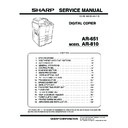Sharp AR-651 (serv.man23) Service Manual ▷ View online
AR-651/810 COPY PROCESS 3 - 7
Combined use of transfer belt and
separation finger
To prevent the copy paper from failing to
be separated during the operation, due to
incomplete transfer belt charging or
absorption of moisture, and thus jamming
up the cleaner, a separation finger
mechanically separates any copy paper
which fails to be separated.
(6) Transfer/Separation
Transfer:
Transfer is a process of transferring the toner image
(visible image) formed on the drum surface onto the
paper.
An electric charge applied by the high voltage power
supply flows to the transfer belt from the power
supply roller. Then it flows to the paper and OPC
drum. The toner, which has been developed on the
drum's surface, is transferred to the paper by elec-
trostatic attraction.
Separation:
The paper is held to the belt and separated from the
drum by the electrostatic attraction acting between
the belt (plus charge) and the polarization charge
(minus charge) on the bottom surface of the paper.
Drum
Paper
Transfer
belt
belt
Rotation of drum
Transfer belt
Paper movement
Separation finger
Reference
•
Drum
E
Toner
Transfer belt
Power supply roller
Paper
Aluminum conductive base
OPC layer
AR-651/810 COPY PROCESS 3 - 8
(7) Fusing
Fusing is a process of melting and fixing the toner
on the paper.
Method : The melting point of the toner (main
ingredient: resin) is 100~110°C.
훹
(Heat)
The toner is melted by the heat of the
surface of the fuser roller.
+
(Pressure) The pressure roller is pressed against
the fuser roller by the springs to increase
adherence of the melted toner to the
paper.
훹
Heat and pressure are applied to the
paper when it passes between the fuser
roller and pressure roller.
||
(Fusing)
The toner is fixed on the paper.
Fuser roller
Paper
Pressure
Heat
IH coil
Fuser roller
Paper movement
Pressure
Separation finger
Pressure roller
(8) Cleaning
Cleaning is a process of recovering any residual toner
on the photoconductive drum.
1. The cleaning brush scrapes off any toner
and paper wastes. The flicker scrapes off any
toner on the brush.
Also, too prevent the cleaning blade from
scratching the surface of the drum to make a
circumferential streak, the varistor is attached
between the brush and earth.
2. Cleaning blade scrapes off any residual toner
from the drum.
3. The recovery blade picks up any falling toner.
Cleaning blade
Flicker
Recovery blade
Cleaning brush
Drum rotation
AR-651/810 COPY PROCESS 3 - 9
(9) Discharging
Discharging is a process of eliminating any (–)
charge remaining on the OPC drum before the next
charging process begins.
If discharging does not occur, the following
phenomenon could occur:
The (–) charge remains on the photoconductive
drum.
Uneven charge is applied to the drum during the
next copy.
훹
The next copy has a double image. (Preceding image
appears.)
Solution :
Expose the entire surface of the OPC drum to the
light by the discharge LED array.
훹
The OPC drum becomes electrically discharged.
훹
All the (–) charges remaining on the OPC drum are
conducted to the ground.
훹
The preparation for the next copy is completed.
Dischage LED array
Drum
훹
AR-651/810 COPY PROCESS 3 - 10
3. 3. Comparison of Copy Process to AR-650/800
Process
1. Photoconductive drum
(1) Sensitivity
(2) Surface potential
2. Charging
3. Surface potential controlling
4. Writing
(1) Light source
Semiconductor laser (adjustment
Same as AR-650/800
not required)
(2) Light amount
4.0 nJ/mm
2
3.8nJ/mm
2
5. Image density control
Image quality sensor
Same as AR-650/800
6. Development
(1) Magnetic roller
(1) Magnetic roller
Two magnetic rollers
Same as AR-650/800
(2) Auto-toner
Magnetic bridge-circuit method
Same as AR-650/800
(3) Toner supply
Toner hopper system
Toner cartridge system
(There is a toner recycle system.)
(4) Toner-empty detection
Density detection method/lever joint
Density detection system
use
(5) Toner
T-6570/6570E
T-6510/6510E/6510D
(6) Developer material
D-6570J
D-6510
(7) Developer bias
DC-400V + AC
DC-500V + AC
7. Transfer
(1) Transfer
Transfer belt
Transfer belt
(Electrical resistance is lower than
AR-650/800.)
(2) Power supply roller
Power supply roller
Power supply roller
Separation auxiliary roller
Separation auxiliary roller
8. Separation
Transfer belt charging
Same as AR-650/800
Separation finger applied
Same as AR-650/800
9. Discharging
(1) Discharging position
Discharge by exposure after cleaning Same as AR-650/800
(2) Discharge lamp
Discharge by red LED
Same as AR-650/800
(3) Pre-cleaning discharge
None
Same as AR-650/800
10. Cleaning
(1) System
Blade + Brush
Same as AR-650/800
(2) Recovered toner
Not acceptable
Reuse (by the toner recycle system)
11. Cleaning brush bias
Earth
Varistor 430V
AR-650/800
AR-651/810
OD-6570 (OPC drum)
OD-6510 (OPC drum)
Highly sensitized drum
Same as AR-650/800
–650 V (grid voltage –720V)
–700 V (grid voltage –733V)
Scorotron method (constant current)
Same as AR-650/800
Grid output variable
Same as AR-650/800
None
Surface potential sensor
Click on the first or last page to see other AR-651 (serv.man23) service manuals if exist.

